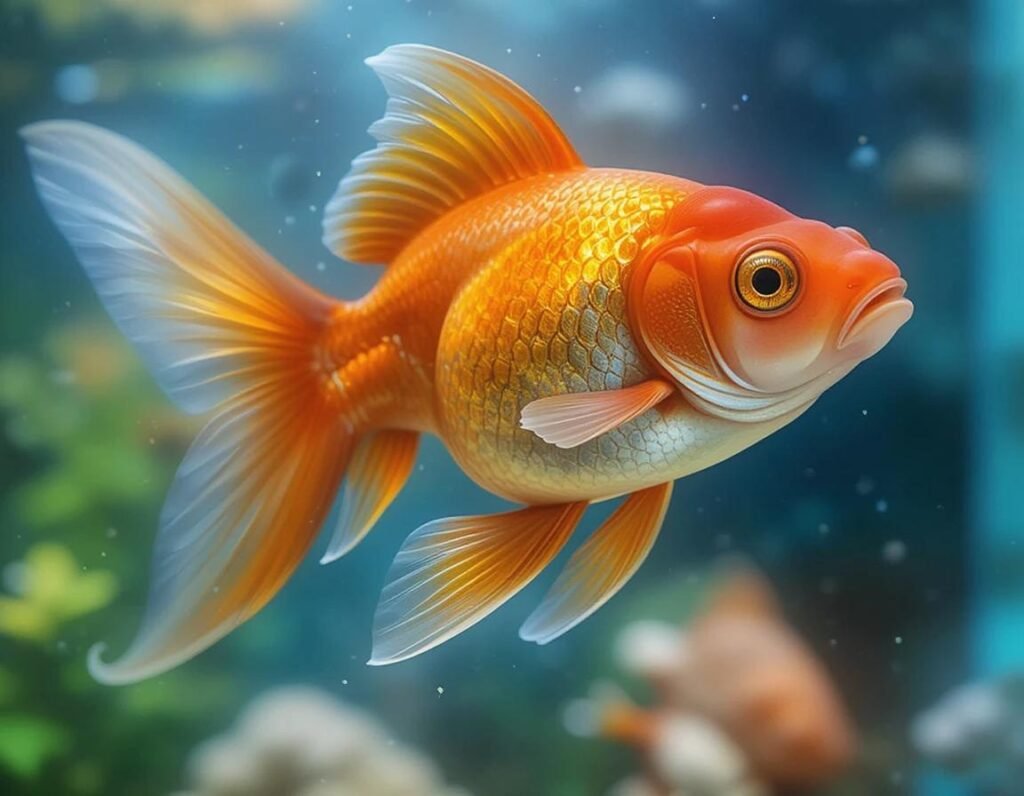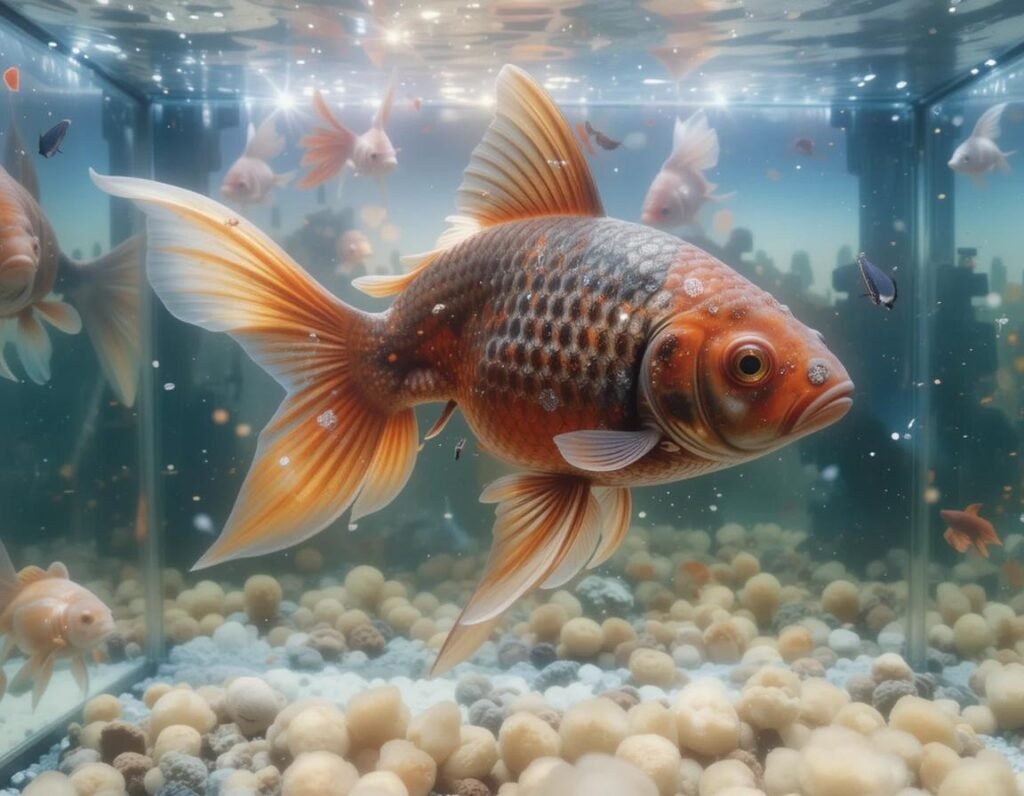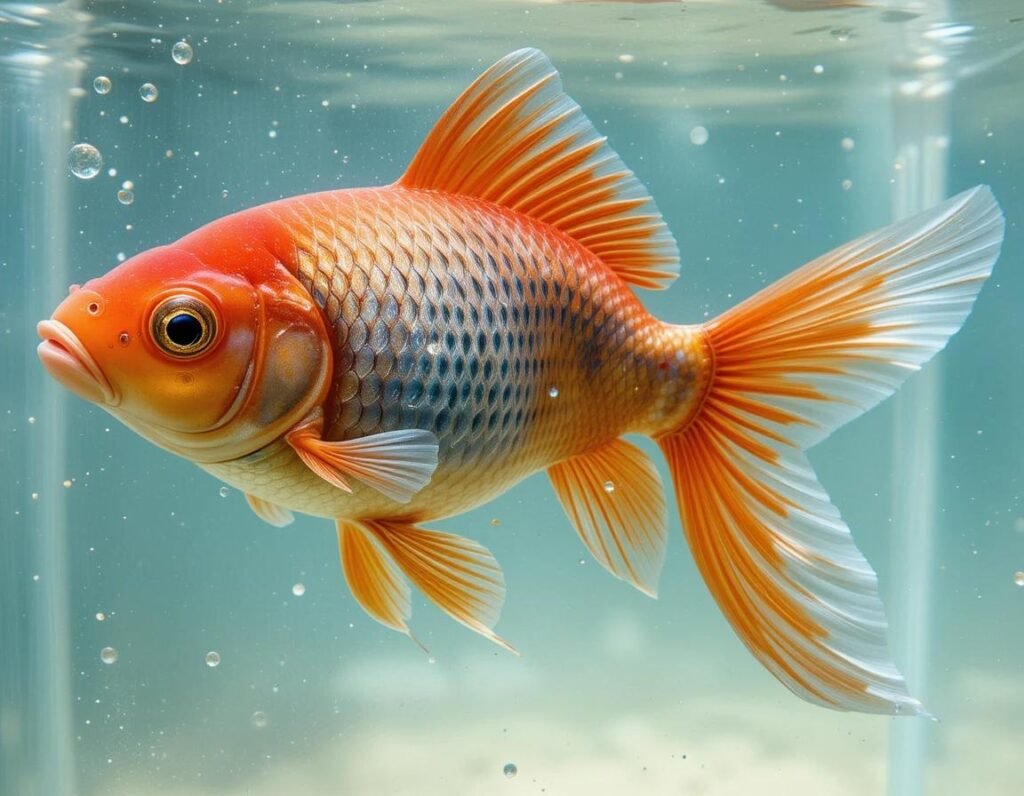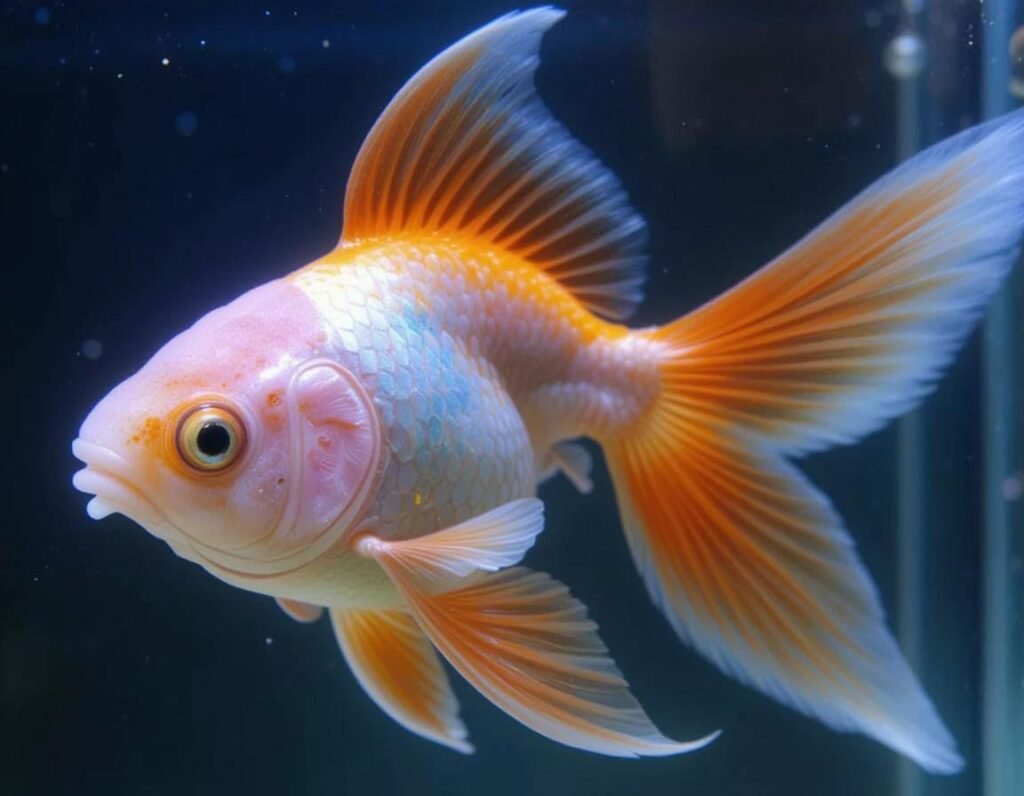
Goldfish aren’t just those cute little fish swimming in ponds and tanks – they’re practically the royalty of the fish world, with so many different types that you could start a mini-aquarium museum. From the classics to the fancier varieties, each type of goldfish has its own distinct charm and unique personality. So, whether you’re new to the goldfish world or a seasoned fish enthusiast, here’s a guide to the most popular types of goldfish to help you find your perfect match.
1. Common Goldfish – The "Classic"
Common goldfish are exactly what you picture when you think “goldfish.” They’re the sturdy, dependable type – orange, streamlined, and all-around classic. These guys are active swimmers and can grow up to 12 inches if given enough space. Known for being low-maintenance, they’re ideal for beginners. Just don’t let their name fool you – with the right care, they’ll dazzle you with their brilliant colors and energy.
2. Comet Goldfish – The “Energetic Athlete”
Comet goldfish look similar to common goldfish but with a twist – a long, flowing tail that’s almost like a fancy ribbon trailing behind them. These guys are natural swimmers, zooming around the tank like they’re in an underwater race. Comet goldfish need plenty of space, so don’t expect them to stay small or confined in a bowl. They’re the sprinters of the goldfish world, and they’ve got the tail to prove it!
3. Fantail Goldfish – The “Double-Trouble Beauty”
If you’re into fancy, the Fantail goldfish might just steal your heart. Unlike their single-tailed cousins, Fantails have a double tail and a round, egg-shaped body that makes them look extra elegant as they drift along. Fantails are slower swimmers, so they tend to be calmer and more laid-back. If a common goldfish is like a goldfish in a hurry, a Fantail is more of a “slow and steady wins the race” type.
4. Oranda Goldfish – The “Brainy” Goldfish
One of the most striking types, the Oranda goldfish has a special “wen” or head growth that makes it look like it’s wearing a stylish brain hat. This quirky feature gives the Oranda a unique look and has earned it plenty of fans. Orandas come in a variety of colors, including red, white, and even blue! Keep an eye on that fancy headgear, though – it needs clean, well-maintained water to stay healthy.
5. Black Moor Goldfish – The “Midnight Beauty”
For those who like a touch of mystery, the Black Moor goldfish is as mysterious as they come. This goldfish is entirely black with telescope eyes that give it a distinctive look. Black Moors are slower swimmers and a bit more sensitive to tank conditions, but they make up for it with their captivating dark color and unique eyes. They’re like the “little black dress” of the fish world – simple, classic, and always stunning.
6. Ryukin Goldfish – The “Chunky Charmer”
Ryukin goldfish are instantly recognizable for their humped backs and round, plump bodies. They come in a rainbow of colors and are a popular choice for those who appreciate a little extra “curviness” in their fish. Ryukins are active and have bold personalities, so they’ll definitely stand out in any tank. With their full-bodied frame, they’re the goldfish equivalent of a lovable sumo wrestler.
7. Bubble Eye Goldfish – The “Living Water Balloon”
If you want a conversation piece, the Bubble Eye goldfish is definitely it. This unique goldfish has fluid-filled sacs under its eyes that give it a cartoonish, almost alien look. Bubble Eyes are delicate and need a tank free from sharp edges to avoid accidentally popping their famous “bubbles.” They’re slower and a little more fragile, so handle (and watch!) with care.
8. Shubunkin Goldfish – The “Colorful Calico”
Shubunkins are like the punk rockers of the goldfish world. They have a striking mix of colors – red, blue, black, orange – all splashed together in a unique, calico pattern. Shubunkins are fast swimmers, so they do best in larger tanks where they can show off their colors and speed. Think of them as the “artistic” type with a bit of an attitude.
9. Pearlscale Goldfish – The “Little Round Ball”
The Pearlscale goldfish looks like it’s dressed in a suit of armor – its scales are thick, round, and give it a pearly, bumpy appearance. This goldfish is adorably round, making it look like a waddling water balloon with fins. Pearlscales are a bit more sensitive to temperature changes, so they need a stable tank environment. They’re quirky, fun to watch, and guaranteed to make you smile.
10. Telescope Eye Goldfish – The “Bug-Eyed Cutie”
Telescope Eye goldfish are exactly what they sound like – goldfish with big, protruding eyes that look like little telescopes. They come in a variety of colors, including red, black, and calico. Their big eyes are sensitive, so they prefer tanks without too many obstacles. It’s like they’re always in a state of wide-eyed surprise, and who can resist that?

Choosing Your Perfect Goldfish
Whether you’re into the classic style or looking for something more exotic, there’s a goldfish out there for every personality. Remember, each type has its own specific care needs, so choose a goldfish that matches your tank setup and experience level. Most importantly, enjoy the journey – each goldfish brings its own unique character to your aquarium, making it a lively, colorful place.
With the right care, these underwater gems will brighten your day with every swim. And who knows, maybe your goldfish will become the most fascinating (and perhaps the funniest) member of your household! 🐟
Tips for Keeping Your Goldfish Happy and Healthy
Once you’ve chosen the perfect goldfish, the next step is ensuring they live their best life in your tank. Here are some tips to help you keep your new aquatic friends happy, healthy, and swimming strong!
1. Provide Enough Space
Goldfish aren’t small-pool swimmers – they grow, and they need room to explore! Remember that goldfish can reach several inches long, with some varieties growing over a foot. A spacious tank not only keeps your fish comfortable but also prevents issues like stunted growth and tank overcrowding. Think at least a 20-gallon tank for one goldfish and an additional 10 gallons for each extra fish.
2. Choose the Right Tank Mates
Some goldfish are social and thrive with tank mates, but not all varieties get along. For example, active swimmers like Comets or Shubunkins prefer tanks with other active fish, while delicate types like Telescope Eyes or Bubble Eyes might struggle if paired with more energetic tankmates. Generally, it’s best to keep similar types together to avoid “fish drama” and potential accidents.
3. Maintain Excellent Water Quality
Goldfish are hardy, but even they can’t handle poor water quality. Goldfish produce a lot of waste, so regular water changes (about 20-30% weekly) and a reliable filter are essential to keep the tank’s ammonia and nitrate levels in check. Invest in a water test kit to monitor pH, ammonia, nitrites, and nitrates, ensuring everything stays balanced. Clean water = happy fish!
4. Feed a Balanced Diet
Goldfish may love their pellets or flakes, but they’ll appreciate a varied diet just as much as we do! Supplement their usual food with nutritious treats like leafy greens, peas (de-shelled), and even the occasional orange slice. This not only keeps them physically healthy but can also bring out their brightest colors. Just remember: goldfish have big appetites but sensitive tummies, so don’t overfeed.
5. Add Some Fun to Their Environment
Goldfish enjoy a bit of enrichment. Add smooth, safe decorations they can swim around and explore, as well as some live plants if possible – goldfish are nibblers and will enjoy grazing on certain plant varieties. Just avoid anything with sharp edges that could injure their delicate fins (especially if you’ve got a Bubble Eye or Telescope Eye goldfish!).
Final Thoughts on Choosing Your Goldfish
Goldfish are truly fascinating creatures with a lot more personality and variety than most people expect. From the classics like Comets to the quirky beauties like Bubble Eyes, each type brings its own charm to the tank. Not only will they add a burst of color to your home, but they’ll also provide endless entertainment with their unique behaviors, graceful swimming, and sometimes quirky habits.
With the right care, your goldfish can thrive for years, even decades! They’re a true commitment, but with a little extra attention to their specific needs, these golden beauties will reward you with many years of companionship and underwater antics.
So, whether you’re looking for a majestic Fantail, a striking Black Moor, or a playful Shubunkin, there’s a perfect goldfish waiting for you to bring a little splash of happiness into your life. Happy fish-keeping! 🐠
FAQs about Goldfish types
Here are some frequently asked questions about different types of goldfish to help you understand their unique characteristics and care needs:
1. What are the most common types of goldfish?
Answer: The most common types of goldfish include the Common goldfish, Comet, Fantail, Oranda, Black Moor, Shubunkin, and Ryukin. These varieties differ in color, size, tail type, and even body shape, making each type unique!
2. What is the difference between a Common goldfish and a Comet goldfish?
Answer: Common goldfish and Comet goldfish look quite similar, but Comets have a longer, flowing tail. Comets are also more active swimmers and prefer larger tanks to accommodate their energetic nature.
3. Do fancy goldfish need special care compared to regular goldfish?
Answer: Yes, fancy goldfish, like Orandas, Fantails, and Bubble Eyes, often require gentler care. They are typically slower swimmers and may need specific tank setups to avoid injury, especially for types with delicate features like Bubble Eyes.
4. Are all goldfish types compatible with each other?
Answer: Not necessarily. Active varieties like Comets and Shubunkins may outcompete slower, fancy varieties like Telescope Eyes or Bubble Eyes. Pair similar types together to prevent stress and accidental injury.
5. What is the “wen” on Oranda goldfish, and how do I care for it?
Answer: The “wen” is the distinctive head growth that gives Orandas their unique look. It’s important to keep tank water clean to prevent infections, as this head growth is sensitive and can be prone to bacterial issues if the water quality isn’t well-maintained.

6. Why does my Black Moor goldfish look different from other goldfish?
Answer: Black Moor goldfish have a unique black color and protruding “telescope” eyes, which give them a dramatic, midnight look. They’re slower swimmers and a bit more sensitive to light due to their large eyes, so they need a gentle, stress-free environment.
7. What makes Bubble Eye goldfish different?
Answer: Bubble Eye goldfish have fluid-filled sacs under their eyes, giving them a very distinctive look. These sacs are delicate, so Bubble Eyes need a tank free from sharp or rough objects to prevent injury.
8. Do goldfish types have different lifespans?
Answer: While most goldfish can live 10-20 years with proper care, fancy goldfish varieties might have slightly shorter lifespans compared to Common or Comet goldfish due to their more delicate features.
9. Can Shubunkin goldfish live in outdoor ponds?
Answer: Yes, Shubunkins do very well in outdoor ponds. They’re hardy, fast swimmers, and their calico colors make them especially beautiful in natural lighting. Just be mindful of potential predators!
10. What is the most colourful type of goldfish?
Answer: Shubunkins and Calico Ryukins are known for their vibrant, multicolored patterns. They often display shades of red, blue, black, and orange, creating a striking, mottled look that stands out in any tank.
11. Are there goldfish types that stay small?
Answer: While all goldfish have the potential to grow quite large if given the space, certain fancy varieties like Pearlscales and Fantails typically stay on the smaller side compared to Common or Comet goldfish.
12. Can Ryukin goldfish live with other types of goldfish?
Answer: Yes, Ryukins can live with other similar-sized fancy goldfish. Just be cautious about pairing them with faster swimmers like Comets, as Ryukins have a unique, round body shape that makes them slower.
13. Why does my Telescope Eye goldfish look surprised all the time?
Answer: Telescope Eyes have protruding eyes that give them a permanent “wide-eyed” look. It’s part of their unique charm, but it also makes them more sensitive to bright light and tank decorations that could cause injury.
14. Do fancy goldfish types grow as large as common goldfish?
Answer: Generally, fancy goldfish types like Orandas, Fantails, and Bubble Eyes stay a bit smaller, often around 6-8 inches, whereas Common and Comet goldfish can grow over a foot long if given plenty of space.
15. Are there any goldfish types that don’t need a filter?
Answer: All goldfish, regardless of type, benefit from a filter due to the amount of waste they produce. Even hardy types like the common goldfish need filtered, oxygen-rich water to thrive.


